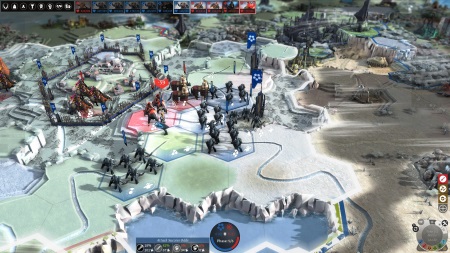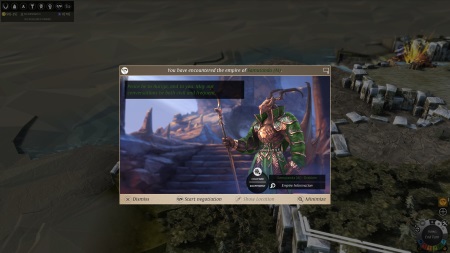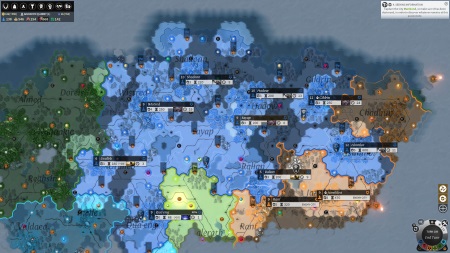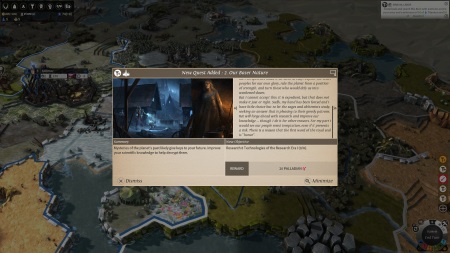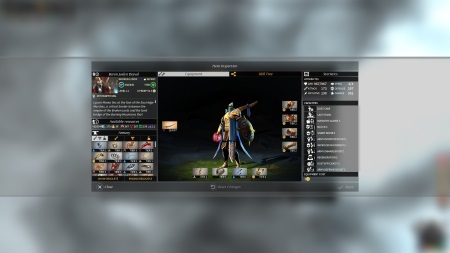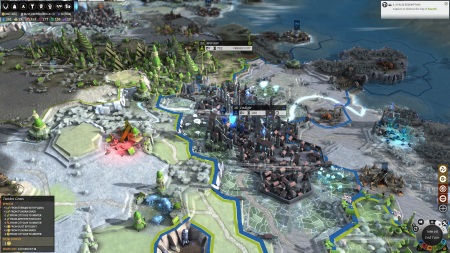Since I chose to skip over Civilization V and its derivatives, the last proper 4x game I played was probably Colonization back in 2009 (I’m not counting the Paradox games here since I don’t really think of them as 4x games). Wow, that was a long time ago. To tell the truth, I was never really very good at them and as I grow older I feel lazier and lazier about learning the unique mechanics of each of these massive strategy games. I’ve tried to keep up with things however so I was vaguely aware of Amplitude Studios’ Endless series. This one, the fantasy-themed Endless Legend, was named Game of the Year for 2014 by Rock, Paper, Shotgun, which was what convinced me to buy it.
Played out on a hex map, Endless Legend superficially resembles other 4X games but is really quite different. For one thing there are predefined regions on the map, much like the Total War games. You can build a city anywhere within a region but there can only ever be one in each region. The map is really busy as well, filled with things like anomalies (geographical features that give various bonuses), ruins that you explore, strategic and luxury resources and the villages of the minor factions. There are also quests. Each faction has its own main quest, granting you very cool benefits in the form of items, technology and heroes, as you complete each stage and side quests offered by ruins and minor faction villages. This means that there’s always plenty to do even before you meet the first enemy faction.
Best of all is that the factions are very strongly differentiated. The Vaulters are apparently the descendants of a starfaring civilization with shades of the Space Marines from Warhammer 40k. They can activate an affinity with a specific strategic resource and units equipped with gear made from that resource, Titanium for example, get a significant boost. Best of all, while their strategic resource boost is activated, they can freely teleport between any of their cities. The Necrophages are a parasitic species who can never befriend any other factions. They can infect enemy units which spawn new Necrophage units when they die and they can consume the dead bodies of enemy units as food. The Broken Lords are animated suits of armor who, instead of food, consume Dust, basically money. Their units never heal naturally and their population never grows. Instead they spend Dust to heal and to create new population. And much more besides.
There are few more unique things about this game. Combat is played out using a turn-based tactical system on the main map itself but after playing for a while I mostly resorted to the auto-resolve system. A resource, Influence, is needed all kinds of diplomatic actions including declaring war. This makes the pacifist faction, the Drakken, viable. They have the ability to force another faction to a truce and it costs Influence to declare war again. Each faction has only three units, apart from the standard Settler. This sounds like very little, until you realize that each unit has equipment slots that you can kit out like in any RPG to upgrade and customize as you wish.
As for how it plays, well, I confess that I hardly ever finish a full game of a typical 4x title. I’d play through the early game multiple times to get a sense of how different factions as well as the game mechanics work, but by the time it hits the late game, I’m usually burnt out. Usually either because victory is preordained but eking it out is still a slog or because late game bloat makes a single turn such a lot of work to properly process. For Endless Legend, not only did I finish games, I actually did it for about half of the factions available in the base game, each with a different victory condition. I even stayed up later than I usually do to do it because this game gave me a terrible case of “just-one-more-turn” syndrome.
There are a number of different reasons why this is so. One is that games have a hard-cap on the number of turns. In normal sized games, this is 300 turns. When the turn limit is hit, the faction with highest score is automatically declared the winner. There’s even a mechanic to help with bloat. Every so often, Winter arrives in the world, dramatically reducing production of everything and slowing movement down for everyone. As the turn counter goes higher and higher, Winters arrive more often and last longer. This acts as a kind of brake on the game, reducing the complexity of the late game and adding pressure to the player to gun for one of the victory conditions. It helps that the various conditions are different enough that you normally won’t achieve one unless you specifically target it. By default you should just win due to the score.
The quests are also an interesting way to give you objectives to achieve beyond simply improving your strategic position. The rewards for completing your faction’s main quests are very powerful, so it’s worthwhile to try to get them done even if you aren’t going for a quest victory. Plus quests are a nice way of pacifying minor factions without having to destroy their villages and then rebuild them or spending money. Still, I note that the quests peter out in in importance sometime around the mid-game and unless you’re going for a quest victory, become completely irrelevant during the end game.
The game does some drawbacks. The lore and all of the fluff surrounding it is nice, especially since the quest allow you to know more about the story of each faction much more than in other 4x games. But it can’t be denied that game mechanics-wise, Endless Legend suffers from a certain dryness. Technological research and unit upgrades basically make your numbers go up, more damage, more food, bigger cities, but don’t fundamentally change how the game plays. Your units play the same role in combat in the late game as in the early game and you’re still using the same units, except with better equipment. It lacks the wow factor of games like Fall from Heaven 2 and the Dominions series. No doubt this makes it easier to program the AI, and I do think that the AI mostly does a reasonable job, especially on the strategic level.
The same lack of excitement is apparent on the static nature of the map. In other games of this type, epic level effects can reshape the landscape and change the nature of the tiles. Not so here. In fact, you can build watchtowers in this game but only on specifically designated hexes within each region. It’s a rather bizarre limitation. There are no game-changing powers available. Even the final set of technological research options just massively boost your production of the various types of resources. How boring!
I also found myself peeved at a couple of other things. The first is how important city building is. Here you can build up districts to increase the size of your city over time. But as players quickly learned there is only one real pattern in which to build them up. One reason why the AI plays reasonably well is that it always builds up cities in this pattern. If you’re not doing the same thing, you won’t be competitive. I also find that the game favors conquering cities a little too heavily for my tastes. Without any expansions, it’s impossible to raid enemies, even the outlying resource extractors. Furthermore, once you take an enemy city, it comes into your hands completely intact. You don’t lose any buildings, any population, even the pacified minor faction villages switch loyalties instantly. The only speed bump is that city approval drops temporarily. Citizens never spontaneously rise up to retake the city either, no matter what the approval rating. This means that conquering cities is incredibly rewarding.
Of course, no game is perfect and if you look at the time I spent on this on Steam, you’ll see how much I ended up liking it. I even bet that those design decisions that I disliked above are part of what makes it a better multiplayer game, though I’m not into that. Overall, a very strong and well paced 4x title.
